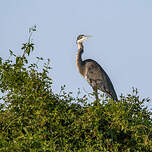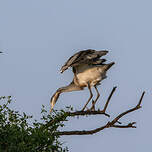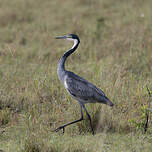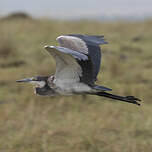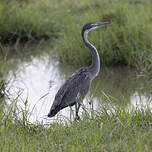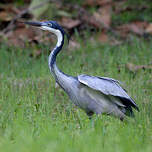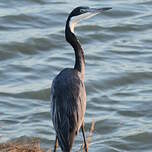Black-headed Heron
Ardea melanocephala - Héron mélanocéphale
Identification
Overall, the Black-headed Heron appears almost uniformly grey but of varying intensity, from very dark to light. The throat is white, contrasting with the cap and the back of the neck. The lightest individuals can be confused with the Grey Heron (Ardea cinerea) but always stand out due to the strong contrast of the underside of the wings which resembles that of White Storks (Ciconia ciconia), with black and white. The darkest ones look quite similar to the Slate-colored Egret (Egretta ardesiaca) but are distinguished by a much larger size and the absence of plumes behind the head. The young have a grey neck and head. They are differentiated from young Grey Herons by their dark flanks and legs. They have dark auricular areas and the underside of the wings.
Subspecific information monotypic species
Foreign names
- Héron mélanocéphale,
- Garza cabecinegra,
- garça-de-cabeça-preta,
- Schwarzhalsreiher,
- feketenyakú gém,
- Zwartkopreiger,
- Airone testanera,
- svarthuvad häger,
- Svarthodehegre,
- volavka čiernohlavá,
- volavka africká,
- Sorthovedet Hejre,
- kobolttihaikara,
- Swartkopreier,
- bernat capnegre,
- Hettuhegri,
- czapla czarnogłowa,
- melnkakla gārnis,
- črnoglava čaplja,
- Черношейная цапля,
- ズグロアオサギ,
- 黑头鹭,
- svarthuvad häger,
- 黑頭鷺,
Voice song and call
Habitat
The Black-headed Heron is a bird of open habitats, particularly cultivated areas (pastures and grasslands). It is only dependent on water for breeding. It has adapted to suburban areas and can look for food on the side of roads. It is a Sub-Saharan species that has been observed in North Africa from time to time. It also lives in Madagascar. It has been seen three times in France (twice in the 19th century and once in the 20th century).
Behaviour character trait
The Black-headed Heron is mainly sedentary as an adult, although some movements may occur towards areas moistened by rain.
It is a colonial bird during the breeding season and it is even aggressive towards its own kind when visiting food sites.
It feeds in shallow waters, looking for prey which it stabs with its long, pointed beak. But it also hunts for small mammals such as rodents, and birds, in cultivated areas. It waits for its prey completely motionless, or walking slowly in order to better track it down.
Flight
The flight of the Black-headed Heron resembles that of a Grey Heron, wide slow movements and retracted neck. Acrobatic figures are observed when the bird descends to land.
Dietfeeding habits
Reproduction nesting
To reproduce, the Black-headed Heron needs large trees with their feet in the water or growing on islets as much as possible.
It then competes with the Grey Heron, which, as an earlier nester, has settled in the best spots. The species forms colonies, sometimes with other species such as the White-breasted Cormorant (Phalacrocorax lucidus) or the Cattle Egret (Bubulcus ibis). The nest is bulky and made of branches of wood. The laying is from 2 to 6 cream-colored eggs, incubated for a little less than a month. The young leave the nest between the 40th and 55th days but only become independent a few days later. As with many herons, they wander through the trees of the colony long before they can fly and do not hesitate to take younger ones from the neighboring nests.Threats - protection
IUCN conservation status
concern
in the Wild
threatened
evaluated
In South Africa, this species has seen an expansion due to increased cultivation and the creation of many water reservoirs. The Black-headed Heron is sensitive to poisoned bait laid by some farmers in order to get rid of predators.
Sources of information
- IOC World Bird List (v15.1), Gill, F and D Donsker (Eds). 2025-12-07.
Other sources of interest
 Specification sheet created on
29/07/2023 by Georges Olioso
Specification sheet created on
29/07/2023 by Georges OliosoTranslation by AI Oiseaux.net
© 1996-2025 Oiseaux.net
- Accipitriformes
- Aegotheliformes
- Anseriformes
- Apodiformes
- Apterygiformes
- Bucerotiformes
- Caprimulgiformes
- Cariamiformes
- Casuariiformes
- Charadriiformes
- Ciconiiformes
- Coliiformes
- Columbiformes
- Coraciiformes
- Cuculiformes
- Eurypygiformes
- Falconiformes
- Galliformes
- Gaviiformes
- Gruiformes
- Leptosomiformes
- Mesitornithiformes
- Musophagiformes
- Nyctibiiformes
- Opisthocomiformes
- Otidiformes
- Passeriformes
- Pelecaniformes
- Phaethontiformes
- Phoenicopteriformes
- Piciformes
- Podargiformes
- Podicipediformes
- Procellariiformes
- Psittaciformes
- Pterocliformes
- Rheiformes
- Sphenisciformes
- Steatornithiformes
- Strigiformes
- Struthioniformes
- Suliformes
- Tinamiformes
- Trogoniformes




















